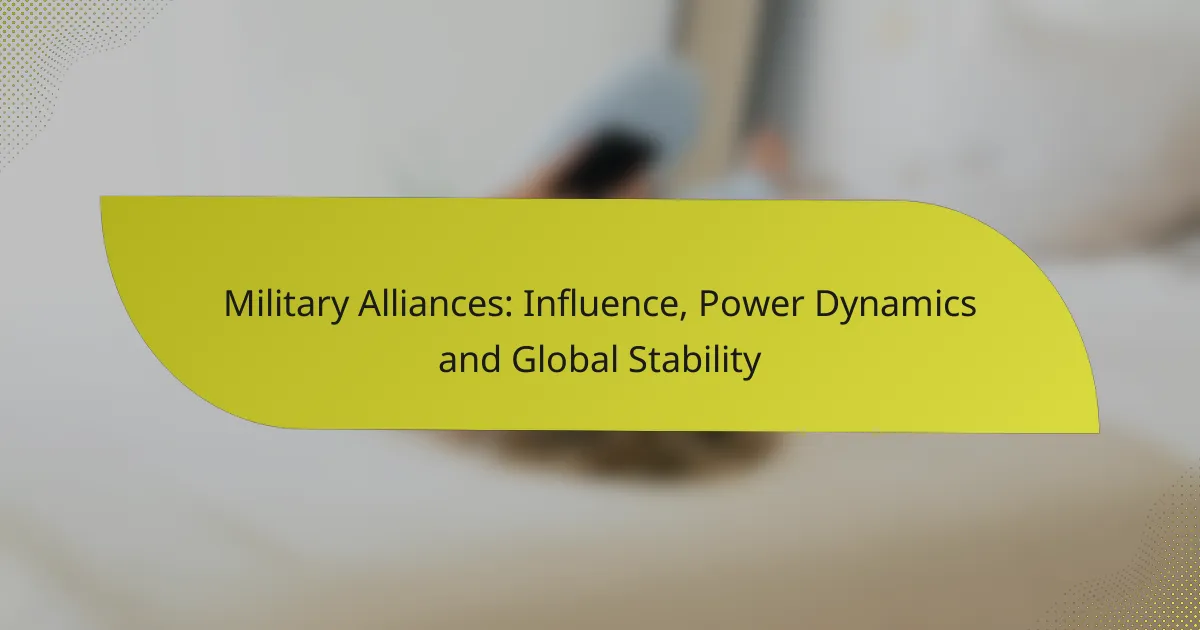Military alliances are essential for maintaining global stability, as they deter aggression and promote cooperation among nations. By influencing power dynamics and diplomatic relations, these alliances play a pivotal role in shaping regional security frameworks and collective defense strategies.

How do military alliances influence global stability?
Military alliances play a crucial role in maintaining global stability by deterring aggression, fostering cooperation, and enabling collective defense among member nations. These alliances can shift power dynamics, influence diplomatic relations, and contribute to regional security frameworks.
Impact of NATO on European security
NATO significantly enhances European security by providing a collective defense mechanism under Article 5, which states that an attack on one member is an attack on all. This principle discourages potential aggressors and promotes stability among member states.
The alliance also conducts joint military exercises and shares intelligence, which strengthens interoperability and readiness. Countries like Poland and the Baltic states benefit from NATO’s presence, feeling more secure against regional threats, particularly from Russia.
Role of ASEAN in Southeast Asian stability
ASEAN fosters stability in Southeast Asia through diplomatic engagement and economic cooperation among its ten member states. By promoting dialogue and conflict resolution, ASEAN helps to mitigate tensions in the region, particularly in the South China Sea.
The organization also conducts joint military exercises and security dialogues, enhancing trust and collaboration among nations like Indonesia, Malaysia, and Vietnam. This cooperative approach reduces the likelihood of conflicts and encourages peaceful resolutions.
Effects of the African Union on conflict resolution
The African Union (AU) plays a vital role in conflict resolution across the continent by facilitating dialogue and deploying peacekeeping missions. Its Peace and Security Council addresses crises in member states, such as those in South Sudan and the Central African Republic.
The AU also emphasizes the importance of regional solutions to conflicts, often collaborating with regional bodies like ECOWAS. This approach not only aids in immediate conflict resolution but also promotes long-term stability and development across Africa.

What are the power dynamics within military alliances?
Power dynamics within military alliances are shaped by the distribution of influence, resources, and strategic interests among member nations. These dynamics determine how decisions are made, how resources are allocated, and how collective defense is executed.
Leadership roles in NATO
NATO operates under a collective defense principle, where member countries agree to mutual defense in response to an attack. The United States typically holds a leadership role due to its military capabilities and funding contributions, influencing strategic decisions and operational planning.
Other key players, such as the United Kingdom and France, also hold significant sway, particularly in European defense matters. The balance of power can shift based on political changes, military needs, and the evolving security landscape.
China’s influence in Shanghai Cooperation Organization
China plays a central role in the Shanghai Cooperation Organization (SCO), which focuses on regional security and economic cooperation. Its influence is evident in the organization’s agenda, which often aligns with China’s strategic interests, including counter-terrorism and economic collaboration.
Member states, primarily from Central Asia, often look to China for investment and security support, which enhances its leadership position. However, this influence can lead to tensions, as smaller nations may feel pressured to align closely with Chinese policies.
United States and its bilateral agreements
The United States engages in numerous bilateral agreements that enhance its military alliances globally. These agreements often include defense cooperation, intelligence sharing, and joint military exercises, strengthening ties with key allies.
For instance, agreements with countries like Japan and South Korea focus on regional security against threats such as North Korea. The U.S. also provides military aid and training, which can create dependencies and influence local military strategies.

How do military alliances shape international relations?
Military alliances significantly influence international relations by enhancing security cooperation, deterring aggression, and fostering diplomatic ties among member states. These alliances can shift power dynamics, impacting global stability and economic interactions.
Military cooperation between the US and Japan
The military cooperation between the US and Japan is anchored in the Treaty of Mutual Cooperation and Security, established in the early 1960s. This partnership allows the US to maintain a strategic military presence in the Asia-Pacific region, which serves as a deterrent against regional threats, particularly from North Korea and China.
Joint military exercises and intelligence sharing are key components of this alliance, enhancing operational readiness and interoperability. The US provides defense support, while Japan invests heavily in its Self-Defense Forces, creating a balanced approach to regional security.
Russia’s partnerships with former Soviet states
Russia maintains military alliances with several former Soviet states through organizations like the Collective Security Treaty Organization (CSTO). These partnerships aim to counter NATO’s influence and ensure regional stability, particularly in Central Asia.
Military cooperation includes joint exercises, arms agreements, and security assistance. However, these alliances often face challenges, such as varying levels of commitment among member states and differing national interests, which can complicate collective defense efforts.
Impact of military alliances on trade agreements
Military alliances can significantly affect trade agreements by fostering economic ties among member countries. Nations in a military alliance may prioritize trade with each other, leading to preferential trade terms and reduced tariffs.
For instance, the North Atlantic Treaty Organization (NATO) members often engage in defense procurement agreements that stimulate trade in military goods and services. However, reliance on military alliances can also create trade dependencies, which may limit a country’s ability to negotiate independently with non-member states.

What criteria determine the effectiveness of military alliances?
The effectiveness of military alliances is primarily determined by member commitment and resources, strategic geographic positioning, and shared political objectives. These factors influence how well allies can collaborate in defense and security operations.
Member commitment and resources
Member commitment refers to the willingness of countries to actively participate in the alliance’s objectives, including military operations and funding. Resources, such as military personnel, equipment, and financial contributions, are crucial for sustaining alliance capabilities.
For example, NATO members are expected to allocate a minimum of 2% of their GDP to defense spending. This commitment ensures that all members can contribute effectively to collective security efforts.
Strategic geographic positioning
The geographic location of alliance members can significantly impact their effectiveness. Countries positioned near potential conflict zones can provide rapid response capabilities and logistical support, enhancing the alliance’s overall readiness.
For instance, alliances that include nations bordering volatile regions, such as Eastern Europe or the South China Sea, can leverage their proximity to deter aggression and respond swiftly to threats.
Shared political objectives
Shared political objectives among alliance members foster unity and coordinated action. When countries have common goals, such as countering terrorism or promoting regional stability, they are more likely to collaborate effectively.
Alliances like the European Union (EU) not only focus on military cooperation but also emphasize political and economic integration, which strengthens their collective resolve and operational effectiveness.

How do military alliances adapt to emerging threats?
Military alliances adapt to emerging threats by enhancing collaboration, updating strategic frameworks, and integrating new technologies. This proactive approach ensures that member nations can effectively respond to challenges such as cyber warfare, terrorism, and environmental changes impacting security.
Cybersecurity initiatives in NATO
NATO has recognized the increasing importance of cybersecurity in modern warfare and has implemented various initiatives to strengthen its defenses. These include the establishment of the NATO Cyber Defence Centre of Excellence, which focuses on research, training, and sharing best practices among member states.
Member nations are encouraged to develop national cyber defense strategies that align with NATO’s collective defense principles. Regular exercises and simulations help improve readiness and coordination in the face of cyber threats, which can disrupt critical infrastructure and military operations.
Counter-terrorism strategies in the Global Coalition
The Global Coalition against ISIS employs a multifaceted approach to counter-terrorism, focusing on military, diplomatic, and humanitarian efforts. This includes intelligence sharing, joint military operations, and support for local forces to combat terrorism effectively.
Coalition members work together to disrupt financing for terrorist organizations and counter radicalization efforts through community engagement and education. By addressing the root causes of terrorism, the coalition aims to create a more stable environment in affected regions.
Response to climate change impacts on security
Climate change poses significant risks to global security, prompting military alliances to integrate environmental considerations into their strategic planning. This includes assessing how climate-related events, such as natural disasters and resource scarcity, can exacerbate conflicts and instability.
Alliances are increasingly focusing on resilience-building measures, such as disaster response training and collaboration with humanitarian organizations. By preparing for climate impacts, military alliances can better protect their interests and support vulnerable nations facing environmental challenges.

What are the historical contexts of major military alliances?
Major military alliances have evolved through specific historical contexts that shaped their formation and purpose. These alliances often arise from geopolitical tensions, security needs, and collective defense strategies among nations.
Formation of NATO during the Cold War
NATO, or the North Atlantic Treaty Organization, was formed in 1949 as a collective defense alliance in response to the perceived threat from the Soviet Union. Its primary goal was to ensure mutual defense among member states, particularly in Western Europe and North America.
The alliance established a framework for military cooperation, including joint exercises and strategic planning. NATO’s principle of collective defense, outlined in Article 5, asserts that an attack on one member is considered an attack on all, which has been a cornerstone of its operations.
Evolution of the Warsaw Pact
The Warsaw Pact was established in 1955 as a counterbalance to NATO, comprising the Soviet Union and its Eastern Bloc allies. This military alliance aimed to solidify Soviet influence in Eastern Europe and provide a unified command structure for its member states.
Over time, the Warsaw Pact adapted to the changing political landscape, but it ultimately dissolved in 1991 following the end of the Cold War. Its disbandment marked a significant shift in global military alliances and the balance of power in Europe.
Historical significance of the ANZUS Treaty
The ANZUS Treaty, signed in 1951, is a military alliance between Australia, New Zealand, and the United States. Its significance lies in its commitment to mutual defense and cooperation in the Pacific region, reflecting the strategic interests of the member countries during the Cold War.
This treaty has facilitated joint military exercises and intelligence sharing, enhancing regional security. Despite challenges, such as New Zealand’s nuclear-free policy, ANZUS remains a vital element of defense strategy for its members, particularly in addressing contemporary security threats in the Asia-Pacific region.
